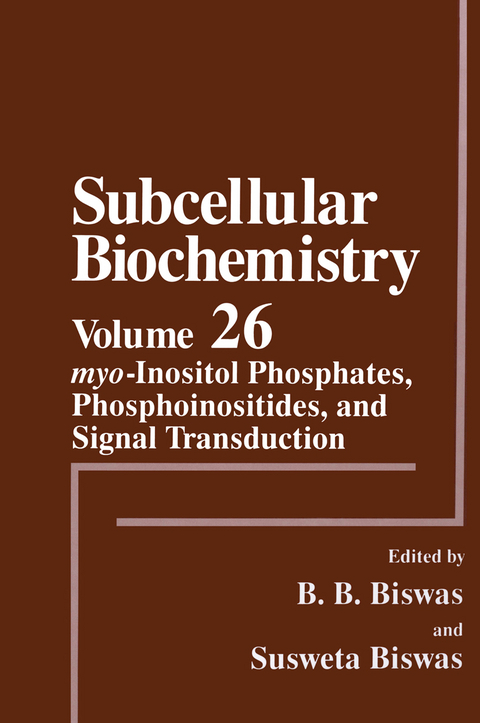
myo-Inositol Phosphates, Phosphoinositides, and Signal Transduction
Springer-Verlag New York Inc.
978-1-4613-8007-8 (ISBN)
1 History of Phosphoinositide Research.- 1. Historical Background.- 2. Modern Era.- 3. References.- 2 Phosphoinositides and Synaptic Transmission.- 1. The Brain Phosphoinositides.- 2. Further Metabolism of Inositol Trisphosphate.- 3. Phosphoinositide-Specific Phospholipase C.- 4. G Proteins and Phosphoinositide-Linked Receptors.- 5. Phosphoinositide-Linked Receptors in Nervous Tissue.- 6. The Inositol Trisphosphate Receptor and Calcium Release.- 7. Inositol-1,3,4,5-Tetrakisphosphate.- 8. Lithium Salts.- 9. Protein Kinase C.- 10. Neuromodulation and Plasticity.- 11. Phosphatidylinositol 3-Kinase.- 12. Phosphatidylinositol Glycans.- 13. The Future.- 14. References.- 3 Control of the Ca2+ Release Induced by myo-Inositol Trisphosphate and the Implication in Signal Transduction.- 1. Introduction.- 2. Functional Regulation.- 3. Heterogeneity of InsP3R.- 4. Partial Ca2+ Release in Response to Submaximal InsP3R Stimulation.- 5. Conclusions.- 6. References.- 4 Regulation of the Actin Cytoskeleton by Inositol Phospholipid Pathways.- 1. Introduction.- 2. Effect of Membranes on Actin and Satellite Proteins.- 3. ras and the Cytoskeleton.- 4. Phospholipase A2 and Arachidonate Metabolism.- 5. Phospholipase C and the Cytoskeletal Response.- 6. Phospholipid Kinases and Cytoskeletal Reorganization.- 7. Effects of Other Phospholipids on the Actin Structure.- 8. Conclusions.- 9. References.- 5 Protein Phosphorylation and Signal Transduction.- 1. Introduction.- 2. Primary Signal Transduction Mechanisms in Eukaryotes.- 3. Signal Transduction Systems in Prokaryotes.- 4. Malfunction and Disease.- 5. Future Directions.- 6. References.- 6 Structural and Functional Roles of Glycosylphosphoinositides.- 1. Introduction.- 2. Structure and Distribution of GPI Molecules.- 3. Biosynthesis and Attachment of GPI.- 4. Glycosylphosphatidylinositol in Insulin Action.- 5. Functional Roles of GPI Anchors.- 6. Conclusions.- 7. References.- 7 Inositol Pentakis- and Hexakisphosphate Metabolism Adds Versatility to the Actions of Inositol Polyphosphates: Novel Effects on Ion Channels and Protein Traffic.- 1. Introduction.- 2. Synthesis of Ins(1,3,4,5,6)P5.- 3. Ins(3,4,5,6)P4 and Ins(1,4,5,6)P4.- 4. Metabolism and Functions of InsP6.- 5. Concluding Statement.- 6. References.- 8 Inositol Phosphates and Their Metabolism in Plant.- 1. Introduction.- 2. Nomenclature of myo-Inositol and Its Phosphates.- 3. Central Role of myo-Inositol in Plant Metabolism.- 4. Metabolism of myo-Inositol Phosphates.- 5. Synthetic Analogues of Inositol Phosphates.- 6. Inositol Pyrophosphates.- 7. Metabolic Processes Involving Inositol Phosphates.- 8. Conclusions.- 9. References.- 9 Genetics of myo-Inositol Phosphate Synthesis and Accumulation.- 1. Introduction.- 2. myo-inositol and L-myo-Inositol 1-Phosphate: Synthesis/Regulation.- 3. Phosphatidylinositol Synthesis and Transport.- 4. Phosphatidylinositol Kinases and Phosphate Kinases.- 5. Phosphatidylinositol-Specific Phospholipase C and 1, 2-Cyclic Inositol Phosphates.- 6. Inositol Phosphate Receptors and Kinases.- 7. Inositol Polyphosphate Phosphatases other than Phytases.- 8. Phytases.- 9. Phytic Acid.- 10. Summary: Current Status of Inositol and Phosphatidylinositol Phosphate Genetics.- 11. References.- 10 Metabolism of myo-Inositol Phosphates and the Alternative Pathway in Generation of myo-Inositol Trisphosphate Involved in Calcium Mobilization in Plants.- Metabolism of Inositol Phosphates in Plants.- 3. Calcium Mobilization and Its Role in Plant Responses.- 4. Phosphoinositides in Plants.- 5. Phosphoinositide and Other myo-Inositol Phosphate Signaling Systems in Plants.- 6. Signaling in Plants by Wounding.- 7. Signaling in Leaf Movement.- 8. Concluding Remarks.- 9. References.- 11 Phosphoinositide Turnover and Its Role in Plant Signal Transduction.- 1. Introduction.- 2. Stress Responses in Unicellular Green Algae.- 3. Pathogen Responses in Higher Plants.- 4. Plant Movements Mediated by Osmotic Changes.- 5. Future Prospects.- 6. References.- 12 Light-Induced Signal Transduction Pathway Involving Inositol Phosphates.- 1. Introduction.- 2. Inositol Phospholipid Turnover as Signal Tranduction in Plants.- 3. Light-Stimulated Inositol Turnover.- 4. Relationship between Inositol Phospholipid Turnover and Physiological Responses.- 5. Alternate Roles for Inositol Phospholipids in Signal Transduction.- 6. Conclusions.- 7. References.- 13 Synthesis, Separation, and Identification of Different Inositol Phosphate.- 1. Introduction.- 2. Synthetic Inositol Phosphates.- 3. Separation.- 4. Identification.- 5. References.
| Reihe/Serie | Subcellular Biochemistry ; 26 |
|---|---|
| Zusatzinfo | 413 p. |
| Verlagsort | New York, NY |
| Sprache | englisch |
| Maße | 152 x 229 mm |
| Themenwelt | Naturwissenschaften ► Biologie ► Biochemie |
| Naturwissenschaften ► Biologie ► Botanik | |
| Naturwissenschaften ► Biologie ► Zoologie | |
| ISBN-10 | 1-4613-8007-3 / 1461380073 |
| ISBN-13 | 978-1-4613-8007-8 / 9781461380078 |
| Zustand | Neuware |
| Haben Sie eine Frage zum Produkt? |
aus dem Bereich


